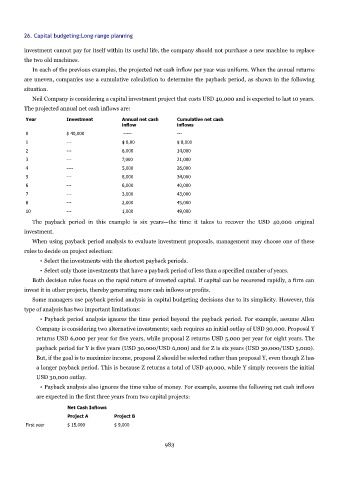Page 982 - Accounting Principles (A Business Perspective)
P. 982
26. Capital budgeting:Long-range planning
investment cannot pay for itself within its useful life, the company should not purchase a new machine to replace
the two old machines.
In each of the previous examples, the projected net cash inflow per year was uniform. When the annual returns
are uneven, companies use a cumulative calculation to determine the payback period, as shown in the following
situation.
Neil Company is considering a capital investment project that costs USD 40,000 and is expected to last 10 years.
The projected annual net cash inflows are:
Year Investment Annual net cash Cumulative net cash
inflow inflows
0 $ 40,000 ----- ---
1 --- $ 8,00 $ 8,000
2 --- 6,000 14,000
3 --- 7,000 21,000
4 ---- 5,000 26,000
5 --- 8,000 34,000
6 --- 6,000 40,000
7 --- 3,000 43,000
8 --- 2,000 45,000
10 --- 1,000 49,000
The payback period in this example is six years—the time it takes to recover the USD 40,000 original
investment.
When using payback period analysis to evaluate investment proposals, management may choose one of these
rules to decide on project selection:
• Select the investments with the shortest payback periods.
• Select only those investments that have a payback period of less than a specified number of years.
Both decision rules focus on the rapid return of invested capital. If capital can be recovered rapidly, a firm can
invest it in other projects, thereby generating more cash inflows or profits.
Some managers use payback period analysis in capital budgeting decisions due to its simplicity. However, this
type of analysis has two important limitations:
• Payback period analysis ignores the time period beyond the payback period. For example, assume Allen
Company is considering two alternative investments; each requires an initial outlay of USD 30,000. Proposal Y
returns USD 6,000 per year for five years, while proposal Z returns USD 5,000 per year for eight years. The
payback period for Y is five years (USD 30,000/USD 6,000) and for Z is six years (USD 30,000/USD 5,000).
But, if the goal is to maximize income, proposal Z should be selected rather than proposal Y, even though Z has
a longer payback period. This is because Z returns a total of USD 40,000, while Y simply recovers the initial
USD 30,000 outlay.
• Payback analysis also ignores the time value of money. For example, assume the following net cash inflows
are expected in the first three years from two capital projects:
Net Cash Inflows
Project A Project B
First year $ 15,000 $ 9,000
983

